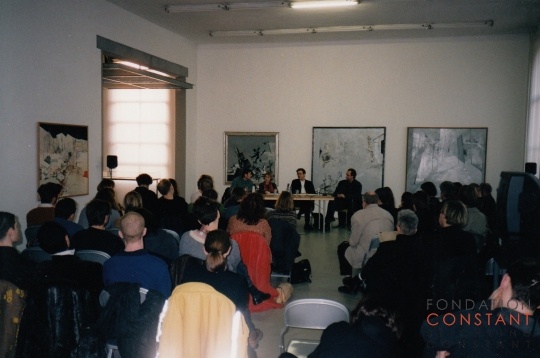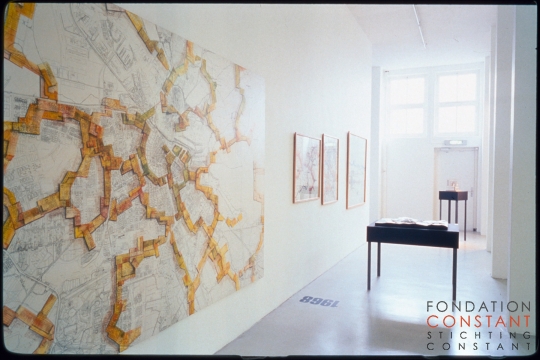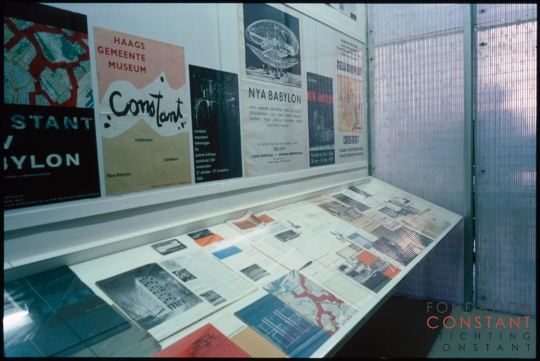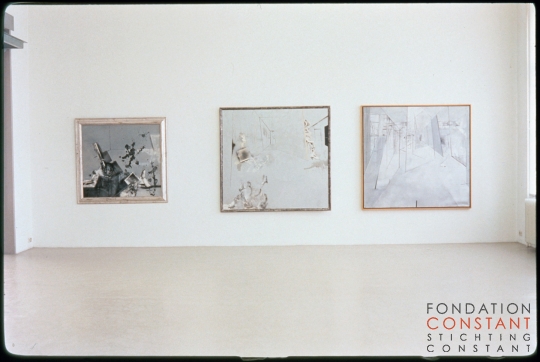Constant / New Babylon
CID
425
At the invitation of Witte de With, the leading architectural historian Mark Wigley put together the exhibition. The exhibition offers a complete overview of Constant's development of his idea New Babylon. Constructions, drawings and graphics anticipating New Babylon introduce a chronological journey through the project. As Constant himself presented his project during his many lectures and presentations, Witte de With is given impressions of the possible appearances of New Babylon by means of huge slide projections with sound.
In 1969 Constant concludes his work on the models of New Babylon and returns to painting. The exhibition at Witte de With concludes with a series of paintings and drawings from the period 1969-74. These show scenes of life in New Babylon, as Constant envisions it. In this, the labyrinthine spaces of New Babylon serve as a background for – partly difficult to discern – representations of sexual acts, social life and aggression.
A specially equipped room with original documents, texts and photos provides further insight into (the history of) the project.
—Partners
Gemeentemuseum Den Haag, The Drawing Center
New Babylon
In 1956, the Dutch artist Constant Nieuwenhuys (Amsterdam, 1920) (previously co-founder of Cobra and between 1958 and 1960 an important member of the Internationale Situationniste) says goodbye to painting and embarks on a grand architectural and urbanistic project, which he calls New Babylon. calls. From that moment on, he worked continuously for almost twenty years on the shaping of his ideas, not only in models, drawings and graphics, but also in manifestos, writings and lectures. With his revolutionary concept, Constant quickly acquired a prominent place in the world of alternative architecture and the discourse associated with it.
With New Babylon, Constant responds to the changes he observed and deemed necessary in society in the fifties: automation is being implemented further and further, as a result of which people increasingly have free time and can move more easily, faster and further by means of transport. the rapidly developing car and air traffic.
New Babylon consists of several interconnected sectors, has no fixed dimensions and is designed for growth. This reticulated, roofed structure extends over the entire earth and rises above the earth's surface by means of pillars. This keeps it free for fast traffic, while the roof offers space for pedestrian promenades and runways for air traffic. Within the sectors, which consist of different levels, people move on foot and with the help of elevators. Climate, light, air treatment and the like are artificially controlled. 24 hours in the sectors of New Babylon yields more experiences and more extreme contrasts than a few weeks' journey in our current world.
New Babylon, a new world for a new society
What is special is that Constant – in contrast to most urban planners – proposes a living environment for a different humanity than today. With New Babylon, Constant assumes an alternative, fully automated society in which human production labor has become superfluous. The classic pillars of living, working, recreation and traffic are all subject to one theme: creativity. The ever-changing appearance of New Babylon's sectors is determined by its inhabitants, the Homo Ludens (the man at play). This human being, relying on the creative qualities of himself and his fellow man, would lead a continuously traveling and creative existence. The autonomous disciplines in the arts – and thus also Constant's own artistic career – are absorbed in the game of the creation of life itself.
Constant has always seen New Babylon as a realizable project, which sparked discussion at academies for architecture and the visual arts. This has ensured, among other things, that New Babylon still occupies a place in art and architecture education, without the project having been physically seen and experienced for the past 25 years.
New Babylon played a pioneering role in the architectural discourse that has influenced the work of groups of architects in the 1960s, such as Archigram, Archizoom and Superstudio and the later Office of Metropolitan Architecture.
Constant's multiform impressions of his plan New Babylon have left indelible traces in many disciplines, such as in the imagination and language of architectural design; to serve in the possibilities of the visual arts as an instrument for innovative social models; in discussions about work, leisure, mobility and creativity; and in the ideas of movements like Provo.
New Babylon and Contemporary Culture
With New Babylon, Constant anticipates the current discussion about the relationship between architecture and virtual space. This discussion – which is not limited to the architectural world – sees electronic space in the same way that Constant imagines the spontaneous construction of fluid and changing situations in the sectors of New Babylon.
In contrast to the time when Constant realized New Babylon, an ephemeral, temporary, mobile and multi-interpretable architecture is already present today. It is therefore important to once again put New Babylon in the spotlight, in order to study and test the possibilities, influences and importance of the project in relation to contemporary practice and recent debates in architecture and urbanism.
At the invitation of Witte de With, the leading architectural historian Mark Wigley put together the exhibition. The exhibition offers a complete overview of Constant's development of his idea New Babylon. Constructions, drawings and graphics anticipating New Babylon introduce a chronological journey through the project. As Constant himself presented his project during his many lectures and presentations, Witte de With is given impressions of the possible appearances of New Babylon by means of huge slide projections with sound.
In 1969 Constant concludes his work on the models of New Babylon and returns to painting. The exhibition at Witte de With concludes with a series of paintings and drawings from the period 1969-74. These show scenes of life in New Babylon, as Constant envisions it. In this, the labyrinthine spaces of New Babylon serve as a background for – partly difficult to discern – representations of sexual acts, social life and aggression.
A specially equipped room with original documents, texts and photos provides further insight into (the history of) the project.
Catalog
The exhibition is accompanied by the monograph New Babylon – The Hyper-architecture of Desire, with texts by Mark Wigley, Constant, and Guy Debord. The monograph was produced in close collaboration with Constant and contains an extensive photographic overview of the development of New Babylon as well as a biography and bibliography. The catalog is published in collaboration with Uitgeverij 010, Rotterdam.
Mark Wigley is chief of theoretical studies at Princeton University New Jersey and author of The Architecture of Deconstruction: Derrida's Haunt (1993) and White Walls, Designer Dresses: The Fashioning of Modern Architecture (1995).
Both the exhibition and the publication are generously supported by the Stimulation Fund for Architecture.
Details
Bibliography
Books
| Title | Year |
|---|---|
| The Hyper-Architecture of Desire | 1998 |
Documentation
| Title | Type | Year |
|---|---|---|
| Constant New Babylon, Metropolis M, nr. 1 | Articles | 1999 |
| De wereld een kuilenstrand | Articles | 1999 |
| The great urbanism game | Articles | 1999 |
| Constants New Babylon is nog steeds actueel | Articles | 1998 |
Exhibition
| Title | Year |
|---|---|
| Another City for Another Life | 1999 |
Photos
No related items available
Text
No related items available
Work
Library
No related items available
Correspondence
No related items available
























